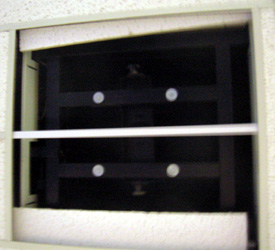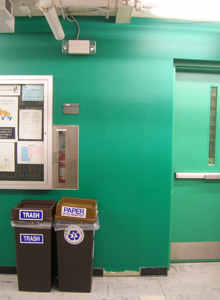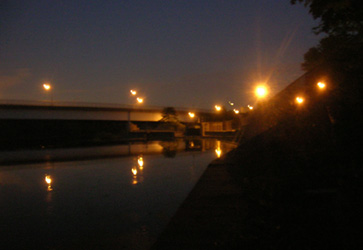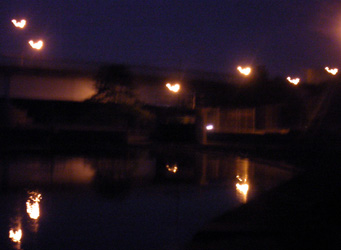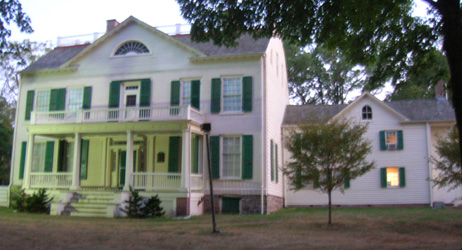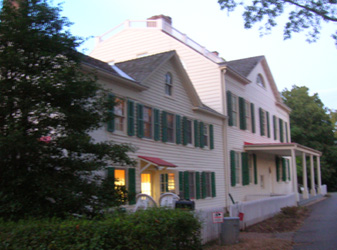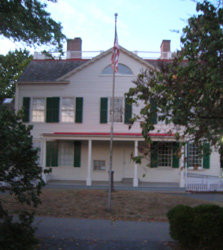

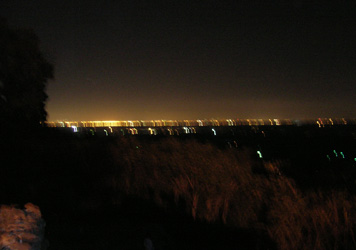

Washington Rock was named for its strategic location up in the Watchung Mountain in Green Brook Township. George Washington used the 30-mile panoramic vantage point during the American Revolution in 1777 to observe the advancements of the British army. The modern view is very scenic, with views of New York City skyline and the Verrazano Bridge on the left side. Although the overlook is quite serene, there are many stories about strange occurrences in the area. One such story from American Folklore describes the Devil on Washington Rock, a human presence of evil who shuts down car engines as they passed. Engulfed by woods, the surroundings are intimidating at night. Those same woods hold the legendary Devil's Tree, which was used for hangings back in the day. The tree has many marks on the trunk from people trying to cut it down, and legend has it that something bad happens to anyone who attempts this feat. It has also been said that the devil chases uninvited guests away. While the investigation of Washington Rock itself did not seem threatening, since it was more of an overcrowded place for teenagers to make out, the woods themselves created an air of uncertainty. While the tourist area does not appear to be worth further investigation, the region does appear worthy of exploration in the future.
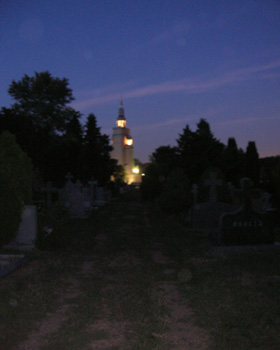
Driving through Bound Brook, I noticed a daunting tower that led to the impromptu investigation of St. Andrew's Ukranian Orthodox Cemetery. Surprisingly, Jessica claimed to have never have seen the site, which caught my eye from not only its sheer size, but its resemblance to Cinderella's Castle at Disney World. There were several statues located in front of and to the sides of the tower, which turned out to be a Ukranian Church, museum, and mortuary. At the east side of the tower was a monument to the women and children who died during the great famine of 1932-33. Behind the tower, there were grave markers as far as the eye could see, most with Ukranian names. We set out at dusk, weaving through the walkways of the cemetery, stopping to admire some of the monuments. The entire cemetery was noticeably well kept, with huge marble family burial plots as opposed to most cemeteries, which typically display less expensive tombstones. As we traveled deeper and deeper into the endless cemetery, night began to fall, but we were nowhere near the end. We decided to commit to reaching the end of the maze, but by the time we got to the grassy area on the edge of Route 287, it was completely dark. The investigation had taken us to the edge, and when we looked back, there was an unexplained sign of life. A flashlight was shining back and forth, and it made sense that the person holding it was searching for us. As we made our way back, expecting to be chastised by an elderly Ukranian caretaker, we realized that the light had been turned off and no one was there. Whether the person was hiding behind one of the tombstones or took off back to the tower, we will never know. It was an eerie feeling walking all the way back to the car, expecting that someone was going to jump out and scare us or attack us. Although we narrowly escaped unscathed this time, you can put money on the fact that we will be back at St. Andrew's tempting the fates again. It's just too interesting to leave unsolved. The full St. Andrew's Account is currently posted.
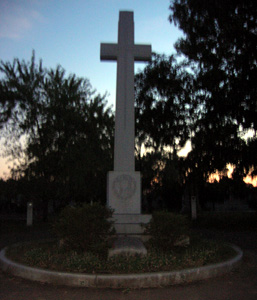

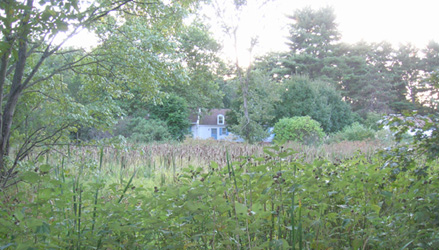
The Van Wickle House was built in 1722 as a wedding present for Evert and Cornelai Van Wickle. The couple died young on the same day in 1757 from what was believed to be a fire. After the death of the couple, the residence was privately owned until 1976, when it was purchased as a historical site. The house is tucked away in an area that now borders Rutgers Preparatory School, and it sits at the base of the Delaware and Raritan Canal near the Raritan River. One common concern expressed by all of the previous owners is the belief that spirits occupy the Van Wickle household. According to Haunted Houses, owners Kay and Ed from 1975-1978 reported puddles of water appearing out of nowhere, flying doililes, voices calling Ed's name, and vanishing apparitions. Matt and Leslie, owners in 1978, reported disappearing items, sounds in the attic, and protective female entities. In 1979, the new caretaker Harry reported screams of tortured souls, pots banging, and dishes rattling throughout the night. A psychic brought in to investigate identified five spirits - two believed to be the Van Wickles' and the others possibly former residents.
The Rutgers Rarities investigation took place during daylight and the first observation was the warped and sunken roof of the house. Many parts of the house and landscape were noticeably restored and renovated, and did not appear as old or historic as we expected. Unable to enter the house, we were limited to viewing the interior through the windows. While there was no direct evidence of spirits aroudn the house during the daylight, the creepiest part of the area was in back of the house by the canal. The stagnant water created a swampy and marshy atmosphere that added a certain mystique to the property. This is another location that should be investigated at night, as the reports of its haunted nature are many.

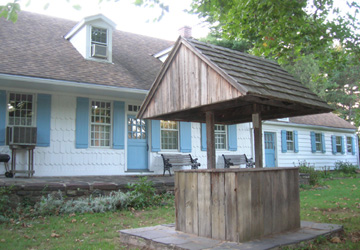
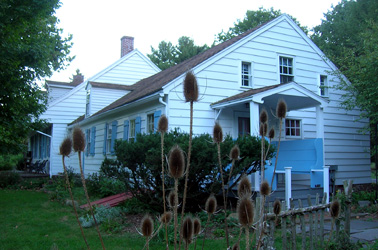
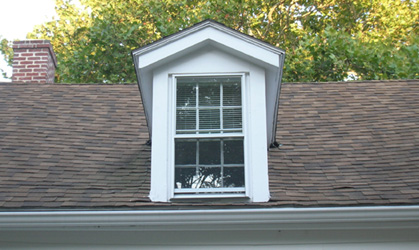
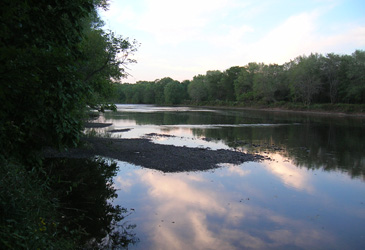


An investigation of the castle during the daytime revealed its splendor, with the main front of the residence adorned with a garden. To the left, there were deep holes from the construction underway, and to the right there was what appeared to be a currently occupied residence, with toys strewn about. It seemed as though there was a family living on the right side of the Kaplan offices, with a trampoline and basketball court in plain view. The most frightening part of the investigation was the appearance of a woman sitting on a bench in the garden. It turned out to be a very lifelike statue in black and gold of an old woman, which was extremely interesting. Further investigations should definitely be conducted on this hidden and forgotten landmark, which has often been said to be haunted.


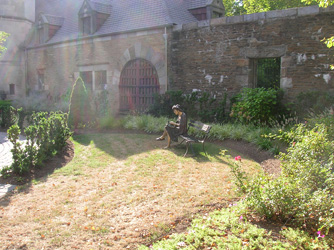
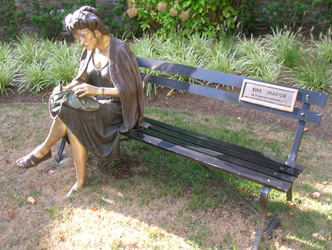
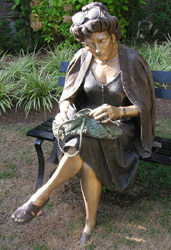
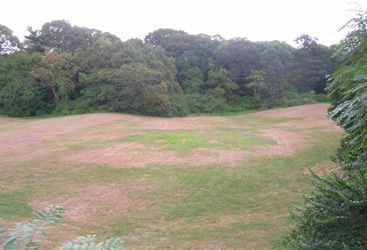
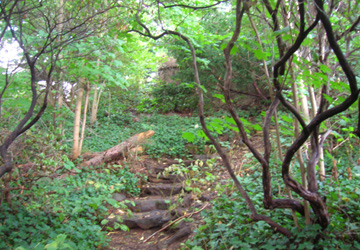
As if the University Inn isn't already the crown jewel of the Rutgers Rarities crown, another discovery was made during a daytime visit to the inn. We were informed that what appeared to be the front of the house was really the back and that the front facade was in the back of the property. We also found out that Henry Carpender, the original owner of Lindenwood, which is now the University Inn and Conference Center, was not only rich, but also very interested in nature and wildlife. The combination of the two made for a beautiful additon to Lindenwood, as exotic plants and trees were imported from all over the world, and rolling hills were artificially constructed in the front yard. Many of the plantlife was on display along an arbor trail that ran through the woods next to the property. During exploration of the trail, many fallen trees and ponds were located. The paths led to a large stagnant body of water that appeared to eventually lead out to Route 18 and toward the Raritan River. The path wound behind Old Gibbons where a rusty old water tank and old appliances were found. Heading back along the water, unidentified bones were discovered, which are shown as part of the Bones Account. We continued the journey through the woods until we were spit out the backyards of a housing complex. Once again, the woods are worth further exploration along the trails that we didn't get a chance to explore. The bones are an indication that there may be something out there.
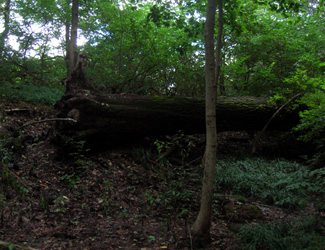

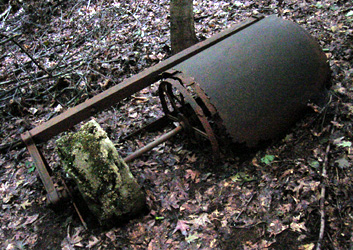
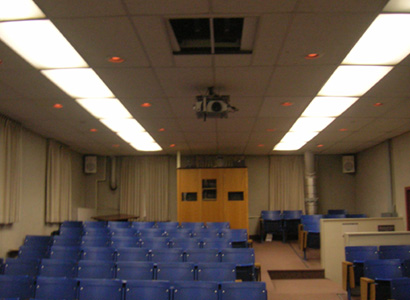
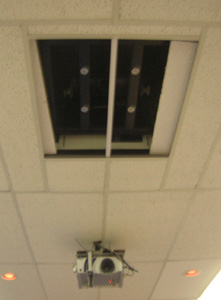
One night while conducting investigations, I noticed a bell tower on the roof of Murray Hall that I found to be rather odd. The Old Queens bell tower near by was said to be haunted by the Grey Lady of Old Queens, but we knew of no way to access the tower. As a second choice, the Rutgers Rarities team looked into the possibility of obtaining roof access in Murray to the bell tower. We walked up to the third floor and found the only room that wasn't locked. It happened to be a classroom that Jessica recalled spending some time in during her undergrad days. Still thinking about the bell tower, we looked at the ceiling and found that there appeared to be a few pannels of sheet rack that didn't fit the normal pattern. After pushing the panels to the side to take a closer look, it appeared as though there was a latch that was a possible way to access the roof. Upon further review, there was a wire running up the side of the panel that we believed to be some sort of alarm system. We were convinced that we could enter the roof through this hatch, but that it would be too risky in case there was a silent alarm that might be activated. We decided not to pursue it further, but it was an interesting find.

